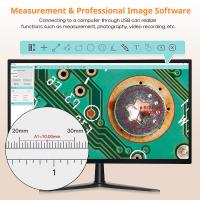How Have Microscopes Developed Over The Years ?
Microscopes have undergone significant developments over the years, from the earliest simple magnifying lenses to the modern-day electron microscopes. The first microscopes were developed in the late 16th century and were simple magnifying lenses that could only magnify objects a few times their original size. In the 17th century, the compound microscope was invented, which used two lenses to magnify objects.
In the 19th century, the development of achromatic lenses allowed for clearer and sharper images. The invention of the electron microscope in the 1930s allowed for even greater magnification and the ability to see structures at the atomic level. In the 1980s, the scanning tunneling microscope was developed, which allowed for the visualization of individual atoms.
Today, microscopes continue to evolve with the development of new technologies such as confocal microscopy, which allows for the imaging of three-dimensional structures, and super-resolution microscopy, which allows for the visualization of structures smaller than the diffraction limit of light. These advancements have greatly expanded our understanding of the microscopic world and have had significant impacts on fields such as biology, medicine, and materials science.
1、 Simple Microscopes
Simple microscopes were the first type of microscopes invented in the 17th century. They consisted of a single lens and were used to magnify small objects. However, they had limited magnification power and were not very effective in observing small details.
In the 18th century, compound microscopes were invented. These microscopes used two or more lenses to magnify objects and were much more powerful than simple microscopes. They allowed scientists to observe cells and microorganisms for the first time.
In the 19th century, the development of better lenses and the use of electricity led to the invention of the electron microscope. This type of microscope uses a beam of electrons to magnify objects and can achieve much higher magnification than traditional microscopes. The electron microscope has been instrumental in advancing our understanding of the structure of cells and molecules.
In recent years, advances in technology have led to the development of new types of microscopes, such as the confocal microscope and the super-resolution microscope. These microscopes use lasers and other advanced techniques to achieve even higher levels of magnification and resolution. They have allowed scientists to observe biological processes in real-time and at the molecular level.
Overall, microscopes have come a long way since the invention of the simple microscope. Today, they are essential tools in many fields of science and have revolutionized our understanding of the natural world.
2、 Compound Microscopes
Compound microscopes have undergone significant developments over the years, starting from the early 17th century when they were first invented. The first compound microscope was invented by Dutch spectacle makers, Zacharias Janssen and his father Hans Janssen, in the late 16th century. However, it was not until the early 17th century that the compound microscope was improved by Galileo Galilei and Johannes Kepler, who added lenses to the device to improve its magnification.
In the 18th century, the compound microscope was further improved by the addition of an adjustable stage and a focusing mechanism. This allowed for more precise focusing and better image clarity. In the 19th century, the development of achromatic lenses improved the quality of the images produced by compound microscopes.
In the 20th century, the development of electron microscopy revolutionized the field of microscopy. Electron microscopes use a beam of electrons instead of light to produce images, allowing for much higher magnification and resolution. The invention of the scanning electron microscope (SEM) in the 1960s allowed for the three-dimensional imaging of specimens.
In recent years, advances in technology have led to the development of new types of microscopes, such as the confocal microscope and the super-resolution microscope. These microscopes use lasers and computer technology to produce high-resolution images of specimens.
Overall, the development of compound microscopes has been a continuous process of improvement and innovation, leading to the creation of new and more advanced types of microscopes. These advancements have greatly expanded our understanding of the microscopic world and have had a significant impact on fields such as biology, medicine, and materials science.
3、 Electron Microscopes
Electron microscopes have undergone significant developments over the years, leading to a revolution in the field of microscopy. The first electron microscope was invented in 1931 by Ernst Ruska and Max Knoll, which used a beam of electrons instead of light to magnify objects. Since then, electron microscopes have undergone several advancements, leading to the development of transmission electron microscopes (TEMs) and scanning electron microscopes (SEMs).
TEMs use a beam of electrons to pass through a thin sample, producing a high-resolution image of the internal structure of the sample. SEMs, on the other hand, use a beam of electrons to scan the surface of a sample, producing a 3D image of the surface structure. Both TEMs and SEMs have undergone significant developments over the years, leading to improved resolution, sensitivity, and speed.
The latest development in electron microscopy is the introduction of cryo-electron microscopy (cryo-EM), which allows the imaging of biological samples in their native state. Cryo-EM involves freezing the sample in a thin layer of ice, which preserves the sample's structure and allows for high-resolution imaging. Cryo-EM has revolutionized the field of structural biology, allowing researchers to study the structure of proteins and other biological molecules at an unprecedented level of detail.
In conclusion, electron microscopes have undergone significant developments over the years, leading to improved resolution, sensitivity, and speed. The latest development in electron microscopy, cryo-EM, has revolutionized the field of structural biology, allowing researchers to study the structure of biological molecules in their native state.
4、 Scanning Probe Microscopes
Scanning Probe Microscopes (SPMs) are a type of microscope that use a physical probe to scan the surface of a sample to create an image with high resolution. The development of SPMs has been a significant advancement in the field of microscopy, allowing scientists to study materials at the nanoscale level.
The first SPM, the Scanning Tunneling Microscope (STM), was invented in 1981 by Gerd Binnig and Heinrich Rohrer. The STM uses a sharp metal tip to scan the surface of a conductive sample, measuring the flow of electrons between the tip and the sample to create an image. The STM was a breakthrough in microscopy, allowing scientists to see individual atoms for the first time.
In 1986, the Atomic Force Microscope (AFM) was invented by Calvin Quate, Gerd Binnig, and Christoph Gerber. The AFM uses a small cantilever with a sharp tip to scan the surface of a sample, measuring the force between the tip and the sample to create an image. The AFM can be used to study non-conductive materials, making it a valuable tool in materials science and biology.
Since the invention of the STM and AFM, SPMs have continued to evolve. New types of SPMs have been developed, such as the Magnetic Force Microscope (MFM) and the Electrochemical Scanning Tunneling Microscope (EC-STM). These new types of SPMs allow scientists to study different properties of materials, such as magnetic fields and electrochemical reactions.
In recent years, SPMs have been combined with other techniques, such as spectroscopy and microscopy, to create new tools for studying materials. For example, the combination of SPMs with Raman spectroscopy allows scientists to study the chemical composition of materials at the nanoscale level.
Overall, the development of SPMs has revolutionized the field of microscopy, allowing scientists to study materials at the nanoscale level with high resolution. As technology continues to advance, it is likely that SPMs will continue to evolve and become even more powerful tools for scientific research.







































